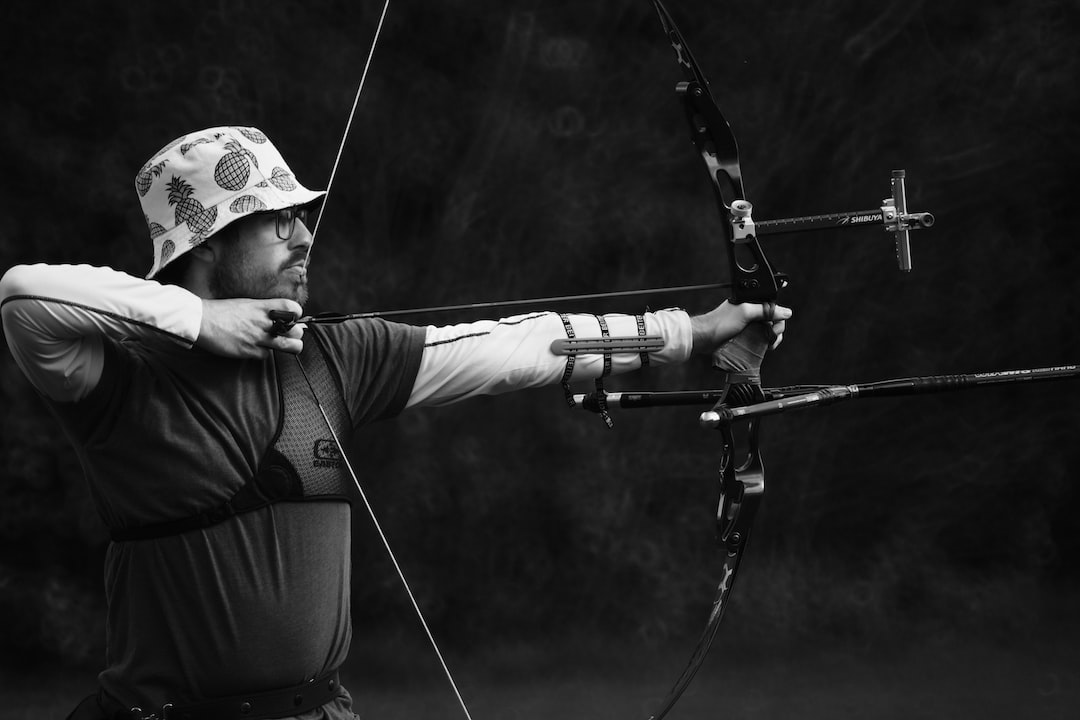Sighting in a bow can seem daunting, but with the right tools and knowledge it doesn’t have to be.
With step by step instructions on how to choose the right bow, setting it up properly before sighting in, paper tuning for accuracy and finally learning how to sight in your bow – you’ll be prepared for any hunt.
So don’t wait another minute – let’s get started on sighting in that perfect shot.
If you are the “read the instructions” kind of learner, go on and keep reading for step-by-step guides on sighting in your bow.
For our visual learners, check out this quick and easy bow sight in video by GoHunt:
Choosing the Right Bow
When it comes to choosing the right bow, there are a few key factors to consider.
The type of bow you choose will depend on your shooting style and experience level. Compound bows are the most popular choice for hunters and recreational shooters alike due to their adjustable draw weight and length, as well as their ability to shoot arrows with greater speed and accuracy than traditional recurve bows.
Types of Bows:
There are three main types of bows available – compound, recurve, and longbow.
Compound bows use cams or pulleys that reduce the amount of force needed to draw back the string while increasing arrow speed when released.
Recurve bows have no cams or pulleys but instead feature curved limbs that store more energy in them when drawn back which helps increase arrow speed upon release.
Longbows have straight limbs with no cams or pulleys which makes them easier to learn how to shoot but also requires more strength from the shooter in order to draw back the string fully before releasing an arrow.
Draw weight is measured in pounds (lbs) and determines the amount of force needed to pull back an arrow’s string fully before releasing it from a bow.
A higher draw weight provides more power behind each shot, however this can be difficult for inexperienced archers who may not have enough upper body strength yet to handle heavier weights. Draw length should also be taken into consideration when selecting a new bow as too short or too long of a draw length can negatively affect accuracy during shooting sessions; this measurement is expressed in inches (in).
Once you have chosen your ideal type of bow along with its desired draw weight and length, there are several accessories you can add onto your setup such as sights, rests, and stabilizers.
These are all designed specifically for different purposes like increased accuracy while aiming at targets further away or reducing vibration after shots so they don’t disturb nearby wildlife during hunting trips outdoors.
With these added features combined together properly on one’s setup, they will definitely help enhance any shooter’s overall performance out on range day.
Choosing the right bow is essential to ensuring a successful hunt, and now that you have your perfect bow set up, it’s time to move on to setting up your sight and rest.
Setting Up Your Bow
When it comes to setting up your bow, there are a few key steps that you need to take in order to ensure optimal performance.
The first step is attaching the sight and rest. Depending on the type of bow you have, this can be done with either screws or bolts. Make sure that everything is securely fastened before proceeding further.
The next step is adjusting the draw weight and length of your bowstring. This will determine how much force is required for you to pull back on the string when shooting an arrow, as well as how far back you can pull it before releasing the arrow.
Adjusting these settings correctly will help improve accuracy and consistency when shooting arrows at a target.
Finally, tuning the string and cables of your bow should also be done prior to use in order to get maximum performance out of it.
This involves making small adjustments such as stretching or loosening certain parts of the strings so they work together properly while firing an arrow from your bow. It’s important not to make any drastic changes here; just minor tweaks should do fine.
These three steps are essential for getting your bow set up correctly for optimal performance each time you go out hunting or practicing archery skills at home or at a range facility. With proper maintenance and regular checks for wear-and-tear over time, your equipment should be able to last many years without needing major repairs or replacements.
Now that your bow is properly set up, you are ready to start paper tuning it for optimal performance. This will help ensure accuracy and consistency when shooting in the field.
Paper Tuning Your Bow
Paper tuning is an important step in ensuring accuracy when shooting with a bow.
Setting up a target for paper tuning is relatively simple and requires only a few pieces of equipment. To begin, you’ll need to attach two sheets of white printer paper to the target, one on top and one underneath.
The top sheet should be placed at least 6 inches away from the bullseye so that it can move freely when shot at. It’s better to have the paper closer to your bow as the arrow is released so you can see if the arrow kicks out a certain direction.
Once the papers are attached, shoot three arrows into the target and observe how they interact with each other as well as with the paper.
If there is tearing to the left, then your arrow is kicking out to the left. Try moving your arrow rest to the right.
If your arrow is kicking out to the right, try moving your arrow rest to the left.
If all three arrows form a perfect triangle shape around the center of your bullseye then you have achieved perfect flight paths and your bow is properly tuned.
Making adjustments to achieve perfect flight paths can sometimes require some trial and error but there are certain steps you can take to ensure success.
First, make sure that your draw weight and length are set correctly according to manufacturer specifications or personal preference. This will help ensure that your arrow has enough power behind it for proper penetration into the target while also allowing it to fly straight without any deviation from its intended path.
Additionally, check that your string and cables are properly tuned by using an Allen wrench or similar tool to adjust them if necessary until they’re just right for optimal performance.
After paper tuning your bow, it is important to make sure that you are sighting in your bow properly for the most accurate and consistent shots. This includes setting up a target, adjusting the sight and testing different arrow weights to find optimal performance.
Sighting In Your Bow
Sighting in your bow is an essential step for any hunter or archer. Properly sighting in your bow ensures that you can accurately hit targets and game animals when hunting. Here are some tips on how to sight in your bow correctly:
Setting Up a Target for Sighting In:
When setting up a target, make sure it’s at least 20 yards away from the shooter and that there is no wind blowing.
Place the target so that it’s perpendicular to the line of fire, as this will help ensure accuracy when shooting arrows. Make sure to use a high-quality target with good visibility; this will help you easily spot where each arrow lands on the target.
Adjusting the Sight to Achieve Accuracy:
Once you have set up your target, adjust your sights until they are level with each other and aligned with the center of the bullseye.
To do this, use a bubble leveler or laser pointer attached to either side of your sight post. You may need to adjust both vertical and horizontal settings until all lines are straight across and centered on the bullseye before shooting arrows at full draw length (the distance between nocking point and arrow rest).
Once you have adjusted your sights, it is important to experiment with different arrow weights in order to find the optimal performance for accuracy and speed.
Heavier arrows tend to fly more accurately but slower than lighter ones; however, if velocity is a priority then selecting an appropriate weight should be done accordingly as heavier arrows require more force from the shooter which can affect precision over long distances or when multiple shots are taken consecutively without rest periods between them.
Additionally, testing various fletching styles such as vanes versus feathers may also improve results depending on individual preference or application needs (e.g., hunting vs competition).
FAQs in Relation to How to Sight in a Bow
What is the sight aiming method for a bow?
The sight aiming method for a bow is an essential technique used by archers to accurately hit their target. It involves using the sights on the bow, such as pins or scopes, to line up with the intended target.
The archer must ensure that they are in proper form and have a steady aim while keeping their eyes focused on the sight. This requires practice and patience to perfect, but when done correctly can lead to increased accuracy and success in hunting or recreational shooting.
Do you follow your arrow when sighting in a bow?
Yes – if your shot is left, move your sight pin to the left. If your shot is right, move your sight pin to the right.
Keep following your shot until you are dialed in.
Additionally, practice shooting from different distances and angles to further improve accuracy and consistency of your shots.
What distances should you sight in a bow?
Sighting in a bow is an important step for any hunter.
The distance at which you should sight in your bow will depend on the type of hunting you plan to do and the terrain you will be shooting from. Generally, most hunters recommend sighting in at 20 yards for traditional archery hunting and 30-40 yards for more modern compound bows.
It’s also important to remember that it’s best to practice shooting from different distances so that you can become comfortable with various ranges when out in the field. Additionally, make sure to adjust your sights as needed if shooting conditions change or if there are changes in elevation or wind speed.
Can you sight in a bow without shooting it?
Yes, it is possible to sight in a bow without shooting it. This can be done by using an archery laser rangefinder or a specialized tool known as a “bow square”.
A laser rangefinder will allow you to measure the distance from your target and adjust the sights accordingly. The bow square is used to align the peep sight with the arrow rest and then use sighting pins on either side of the arrow rest for accuracy.
Both methods require some practice but are effective ways of sighting in a bow without actually firing an arrow.
How far can you sight a 3 pin bow?
The answer to this question depends on a variety of factors, such as the type of bow you are using, the draw weight and length of your arrows, and even environmental conditions.
Generally speaking, most 3 pin bows can be sighted up to around 40 yards with proper technique and practice on a good quality archery target. However, some experienced archers have reported sighting their bows up to 60 yards or more in ideal conditions.
Ultimately it is important to remember that accuracy at longer distances will depend heavily on your skill level and experience with the bow in question.
What are the two main methods for aiming a bow?
The two main methods for aiming a bow are the traditional “anchor point” method and the more modern “aiming off” technique.
The anchor point method involves drawing back the string to your face, finding an anchor point on your face that is consistent with each shot, and then aligning the arrow with this anchor point before releasing.
The aiming off technique requires you to draw back the string, find a reference object in front of you (such as a tree branch or rock), and use it as an aimpoint while shooting.
Both techniques require practice and precision in order to be successful; however, they can both provide accurate shots when used correctly.
Make sure to get some practice shots in wearing your hunting pack and bino harness to emulate a real-life hunting scenario.
Conclusion
Sighting in a bow is an important step to make sure you are getting the most out of your hunting experience.
With the right bow, proper setup and tuning, sighting in your bow can be done quickly and accurately.
Take some time to learn about these steps so that you can sight in your bow with confidence. Doing this will ensure that when it comes time for hunting season, you’ll have a reliable weapon at hand ready to take down any game with accuracy thanks to taking the time to properly sight in your bow.



